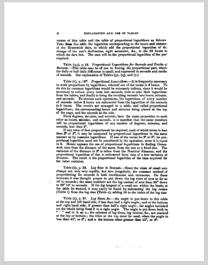
NavList:
A Community Devoted to the Preservation and Practice of Celestial Navigation and Other Methods of Traditional Wayfinding
From: Henry Halboth
Date: 2015 Feb 28, 12:03 -0500
On 2015-02-27, at 9:01 PM, Hanno Ix wrote:Also it seems there were abandoned - why?and how does one use them?Henry,what exactly are proportional logarithms,
what specific problems do they solveIs there anyone else who knows?Proportional logarithms were part of Maskelyne's Tables Requisite and were used to interpolate between the lunar distances given in the Nautical Almanac (the lunar distances were only given for each 3 hour period). Since there are 10800 seconds in 3 hours, the proportional log was defined as log(10800) - log(x). If we designate the lunar distance at time t1 as D1, and the lunar distance at time t2 as D2 (t1 and t2 are 3 hours apart, and D1 and D2 are given in the almanac), and our cleared distance d is somewhere in between D1 and D2, then we can use linear interpolation to get the time t of our actual observation.
10800/(t-t1) = (D2-D1)/(d-D1)
Taking logs we get
plog(t-t1) = plog(d-D1) - plog(D2-D1)
where we can avoid the use of division. The value of plog(D2-D1) comes from the almanac. The value of plog(d-D1) comes from the tables requisite where proportional logs are given for 3 degrees. The difference is then used to look up the inverse proportional log in the same table to get t-t1.
Frank Reed once pointed out that the proportional logs were useful in another way as well. A small value of the proportional log represents a lunar distance that is changing rapidly. If you have two or three stars that might be used to get the lunar distance, the best choice is one where the distance is changing rapidly, so one could look at the proportional logs in the almanac to see which star would give the best data from a lunar observation.
\----------------------------+---------------------------------+ o_,
O_/ \ Ken Muldrew, PhD | Voice: (403) 226-6222 | <\__/7
<\__ \ Programming/Electrical| Cell: (587) 890-3502 | | /
"\ L | Arbourealis RDC, ltd. | kbmuldrew---.com | / /
< +-----------------------+---------------------------------+ / /
Morning coffee recapitulate phylogeny L/







